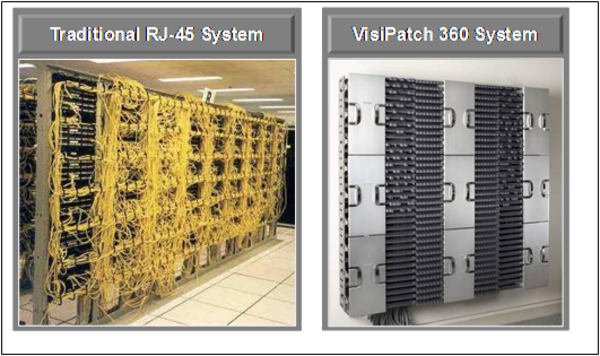Administration of an infrastructure needs to be done right, not only at the initial installation, but throughout the life of the system. Inaccurate or time-consuming connections can be costly, but when panels are festooned with “patch cord spaghetti,” it takes time and care to avoid errors and the disruption they cause. The more connections in a panel, the more cords there are to obstruct technicians implementing moves, adds and changes. With traditional panel designs this is almost inevitable and I am sure we have all experienced similar images to the picture on the left. In fact this picture is probably above average in terms of management!
Added to the dilemma is the fact that the patching frames and connections are probably the most visible part of a cabling system. They are the parts that people see, and quite often the only part they can base their impression of value from.
There are products such as the VisiPatch 360 solution shown on the right, which have been specifically designed to counter this 'spaghetti'. The reduced clutter is both visually elegant and ergonomically functional, providing for clear and easy port labeling, a simpler user experience, and a sophisticated appearance in the communications room.
Patch cord and cable congestion in traditional RJ45 systems can cause usable density to be lower than the actual port density. The key to the efficient cable management is robust vertical and horizontal spaces to increase ease-of-use plus careful and planned execution of moves, adds and changes. Neat, well-organized installations are less likely to hide poor workmanship and also make faults easier to trace. They encourage a careful, organized approach by anyone working on the system. I found this video in our archives and felt it might give some good guidance to those looking for help with patching techniques.
Pressure to get more value from IT investments is ever increasing, so any maintenance cost saving is a welcome way to fund higher performance equipment. Since patch panels are the most complex passive components in a cabling infrastructure, innovative implementation in this area can cut overall operating costs significantly.








